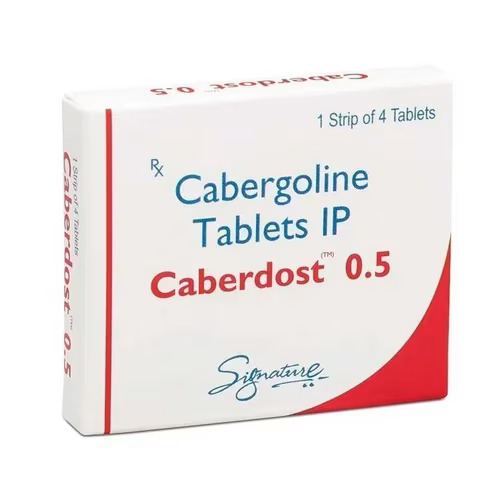Introduction
Elevated prolactin levels—hyperprolactinemia—can interfere with menstruation, suppress fertility, induce erectile dysfunction, and lower bone density. Caberdost 0.5 mg (also known as cabergoline) provides a targeted, effective therapy by influencing the brain’s dopamine receptors. This long-form article covers:
- What prolactin does and what happens in hyperprolactinemia
- How cabergoline works mechanistically
- Pharmacokinetic features of the 0.5 mg dose
- Clinical evidence and benefits
- Typical dosing strategy
- Side effects and safety considerations
- Monitoring and follow-up protocols
- Patient FAQs and practical tips
Let’s dive deep into how this medication works and what users need to know before starting it.
1. Prolactin – Function and Dysregulation
Prolactin is a hormone produced by the anterior pituitary gland that plays roles in:
- Lactation postpartum
- Influencing reproductive function in both genders
- Modulating immune responses and metabolic balance
However, chronically elevated prolactin—hyperprolactinemia—can cause:
- Women: Irregular menstrual cycles, galactorrhea, fertility issues
- Men: Erectile dysfunction, lower sex drive, infertility
- Both: Reduced bone density risk and pituitary tumor formation (prolactinoma)
If left untreated, long-term effects are osteoporosis and cardiovascular risk. Dopamine from the brain naturally inhibits prolactin through D2 receptors in pituitary lactotroph cells .
2. Cabergoline Mechanism – Targeting D2 Dopamine Receptors
Caberdost (cabergoline) is a member of the ergot-derived dopamine agonists class. Its main action:
- Solely activates dopamine D₂ receptors on lactotroph cells, acting like dopamine, inhibiting release of prolactin
- Blocks adenylyl cyclase → lowers cAMP → lessens intracellular Ca²⁺ → halts prolactin exocytosis
It also binds to D₃, D₄, and several serotonin receptors, but the interaction with D₂ in the tuberoinfundibular pathway is the most important for prolactin regulation.
3. Pharmacokinetics of 0.5 mg Cabergoline
Understanding how the drug behaves in the body helps explain its dosing regimen:
- Bioavailability: Approximately 50–80% orally
- Plasma half-life: 63–115 hours—supports twice-weekly dosing
- Metabolism: Primarily hepatic via hydrolysis; minimal CYP450 involvement—low risk for drug–enzyme interactions
- Excretion: 22% via urine and 60% in feces over 20 days
This pharmacokinetic profile offers steady hormonal control despite infrequent dosing.
4. Clinical Efficacy & Evidence
4.1 Rapid Prolactin Reduction
Single doses indicate quantifiable reduction of prolactin within 2 weeks; complete normalization frequently within 4–6 weeks .
4.2 Long-Term Restoration
In a review of over 450 hyperprolactinemic patients:
- High success in normalizing prolactin and resuming regular cycles
A 2004 study found: - 74.5% normalized prolactin within 6 months; 80% in microprolactinomas
4.3 Preferred Over Bromocriptine
Compared to bromocriptine:
- More effective at normalizing prolactin and restoring cycles
- Better tolerated with fewer side effects
4.4 Tumor Shrinkage
Cabergoline works well in shrinking size of lactotroph adenoma, frequently by >25% in 3–6 months; sustained use produces further improvement .
4.5 Remission Post-Therapy
One report mentioned long-term disease remission and lack of tumor regrowth following cessation of the drug after normalization.
5. Dosing Intensity: Why 0.5 mg Tablets?
5.1 Standard Dosage Protocol
- Start: 0.25 mg twice-weekly
- Adjust every 4 weeks until prolactin normalizes
- Maintenance: often 0.5 mg total weekly—usually 0.25 mg each on two days
5.2 Achieving Effective Serum Levels
The long half-life permits infrequent dosing but consistent suppression. 0.5 mg twice weekly achieves robust hormone control with little „peaks and troughs.”
5.3 Tailored Approaches
- Macroprolactinomas or resistant cases: Higher dosing up to 3.5 mg/week
- Special cases (e.g., PCOS with hyperprolactinemia): 0.5 mg weekly has improved cycles and androgen profiles
6. Safety Profile and Monitoring
6.1 Common Side Effects
- GI: Nausea, constipation, stomach discomfort
- Neuro: Headache, dizziness, fatigue
- Cardio: Orthostatic hypotension; low blood pressure episodes
These typically resolve once tolerance develops.
6.2 Rare but Significant Risks
- Cardiac valvulopathy/fibrosis: Very low risk (<0.17% in prolectinoma patients on <2 mg/week)
- Impulse control disorders: Watch for new-onset gambling, hypersexuality, binge eating
- Pulmonary effects: Rare fibrotic changes, reversible upon discontinuation
6.3 When to Screen or Avoid
- Baseline echocardiogram recommended; follow-up every 6–12 months if dose >2 mg/week or other risk factors exist
- Contraindications: Known sensitivity to ergot drugs, uncontrolled hypertension, fibrotic conditions, pregnancy/breastfeeding without supervision
7. Monitoring Strategy
Before starting:
- Echocardiogram for valvular screening
- Baseline labs (prolactin, liver, renal function)
During therapy:
- Prolactin levels every 4–12 weeks until stable
- Blood pressure monitoring
- Echocardiogram tracking (especially if higher dose)
- MRI if prolactinoma present—usually at baseline, 3–6 months, then annually
After discontinuation:
- Maintain prolactin checks every 3–6 months
- MRI if prolactin starts rising again
8. FAQs – Clear Answers for Patients
Q: How quickly does Caberdost lower prolactin?
Within 1–2 weeks for initial decline; full normalization usually takes 4–6 weeks.
Q: Can I take it with food?
Yes—taking with meals or before bed helps minimize nausea.
Q: Will high prolactin return after stopping?
About 20–40% may relapse, particularly if treatment lasted less than 2 years .
Q: Is pregnancy safe?
Often discontinued before conception; some data show no fetal risk if used early .
Q: Does it cause weight gain?
Generally no; stabilizing prolactin can support better metabolic health.
Q: What if I miss a dose?
Take as soon as remembered, unless the next scheduled dose is soon; do not double-doses.
9. Tips for Optimal Use
- Consistent scheduling—e.g., Monday & Thursday each week.
- Stay hydrated and rise slowly to reduce vertigo.
- Report mood or behavior changes which may hint at impulse control issues.
- Keep follow-up labs & imaging appointments for monitoring.
- Let every provider know you’re taking cabergoline—it can affect medical procedures.
- Store properly: Room temperature, dry place, away from sunlight.
10. Conclusion
Caberdost 0.5 mg (cabergoline) provides a stable, focused, and well-tolerated treatment option for hyperprolactinemia. By stimulating dopamine D₂ receptors in the pituitary, it successfully lowers prolactin, corrects hormonal balance, and frequently reduces pituitary tumors. With once-a-week convenience, low drug–interaction potential, and good safety profile, it’s the treatment of choice in most guidelines .
However, achieving optimal outcomes means combining effective therapy with careful monitoring:
- Baseline and follow-up echocardiograms
- Regular prolactin checks
- Awareness of rare side effects


